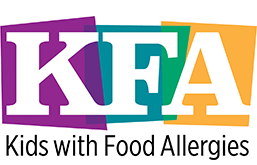Advocacy

Food Allergen Ingredient Labeling
We’ve come a long way in the efforts to get food manufacturers to list allergens on food ingredient labels. But there is still a lot more work to do. People managing food allergies need clearer food allergen labeling so they can better prevent allergic reactions.
The 2004 Food Allergen Labeling and Consumer Protection Act, or FALCPA, set standards for allergen labeling for foods. According to FALCPA, these are the major allergens:
- Milk
- Eggs
- Fish (such as bass, flounder)
- Crustacean shellfish (such as lobster, shrimp, crab)
- Tree nuts (such as almond, pecans, walnut, coconut)
- Peanuts
- Wheat
- Sesame (as of Jan. 1, 2023)
- Soy
Any product that is regulated by the Food and Drug Administration (FDA) has to declare the presence of one of these allergens. They must use plain language – for example: lecithin (soy), flour (wheat), and whey (milk).
FALCPA has made life easier for people in the U.S. who manage one or more allergies to these major food allergens. But we need better policies to help people prevent food allergy reactions and make safe food choices.
Closed
Precautionary Allergen Labeling
Have you ever seen an ingredient label that says, “May contain…,” “Made in a facility with…,” or “Made on the same lines as…,” These are called “precautionary labels.” But they aren’t regulated or required by law. They can be confusing to shoppers who are trying to make decisions about what foods are safe to eat.
In order to improve precautionary labeling, we need to know more about how much of an allergen can cause a reaction.
AAFA and KFA support research to identify these levels (thresholds) and inform the development of labels that are consistent, reliable, and evidence-based.
Sesame Labeling
Sesame allergy has increased in recent years, adding it to the list of major allergens.1 Sesame allergy can be more severe than some of the other top food allergies. About one in three adults and children with sesame allergy go to the emergency room in for reactions to sesame.2
AAFA and KFA worked with Congress and the FDA to advocate for to be included in the list of major allergens. In 2021, Congress passed the Food Allergy Safety, Training, Education, and Research Act (FASTER) requiring sesame labeling starting in 2023.
We will keep working with the FDA and with the food allergy community to ensure that sesame labeling will go smoothly.
Non-FDA Regulated Products
FALCPA’s allergen labeling requirements only cover products regulated by the FDA. They do not apply to alcoholic beverages (regulated by the Department of Treasury) or meat, poultry, and egg products (regulated by the U.S. Department of Agriculture).
Allergen labeling is voluntary for these products. This is confusing for consumers with food allergies. We support policy efforts to make allergen labeling for all food products consistent with products regulated by the FDA.
Our Advocacy Efforts for Food Allergy Ingredient Labeling
AAFA and KFA support policies and laws that save lives and improve the quality of life for millions of people and families managing food allergies. Because this issue is one of our key policy priorities, we have been actively working to on behalf of the food allergy community to spread awareness to policymakers and other stakeholders. Here is some of the work we have been doing:
AAFA Comment Letter on FDA Evaluation of Food Allergens![]() – August 17, 2022
– August 17, 2022
AAFA Sends Letter to White House of Food Allergy Policy Recommendations![]()
![]()
![]()
![]()
![]()
![]()
![]()
![]()
![]()
![]()
![]()
![]()
![]()
![]()
![]()
![]()
![]()
![]()
AAFA Signs Letter to Congressional Appropriations Leadership Requesting Mandatory Alcohol Labeling![]()
![]()
![]()
![]()
![]()
![]()
![]()
![]()
![]()
![]()
![]()
![]()
![]()
![]()
![]()
![]()
![]()
![]()
A Year in Advocacy – Better Food Labeling, Anaphylaxis Policies, and Healthy Schools – December 20, 2021
AAFA Sends Comment Letter Regarding Smarter Food Safety and E-Commerce![]()
![]()
![]()
![]()
![]()
![]()
![]()
![]()
![]()
![]()
![]()
![]()
![]()
![]()
![]()
![]()
![]()
![]()
AAFA Signs Letter Supporting the Food Labeling Modernization Act![]()
![]()
![]()
![]()
![]()
![]()
![]()
![]()
![]()
![]()
![]()
![]()
![]()
![]()
![]()
![]()
![]()
![]()
Food Allergy Advocacy Win: The President Signs the FASTER Act and Makes Sesame a Major Allergen – April 23, 2021
AAFA Sends Letter Urging House Scheduling of the FASTER Act of 2021![]()
![]()
![]()
![]()
![]()
![]()
![]()
![]()
![]()
![]()
![]()
![]()
![]()
![]()
![]()
![]()
![]()
![]()
Advocacy Update: Congress Reintroduces Bill on Sesame Labeling and Food Allergy Research – March 4, 2021
AAFA Sends Comment Letter Urging Mandatory Allergen Labeling for Sesame![]()
![]()
![]()
![]()
![]()
![]()
![]()
![]()
![]()
![]()
![]()
![]()
![]()
![]()
![]()
![]()
![]()
![]()
AAFA Sends Memorandum in Support of A4486/S454 Regarding Sesame Labeling![]()
![]()
![]()
![]()
![]()
![]()
![]()
![]()
![]()
![]()
![]()
![]()
![]()
![]()
![]()
![]()
![]()
![]()
AAFA Sends Letter Urging the FDA to Make Sesame Allergen Labeling Mandatory![]()
![]()
![]()
![]()
![]()
![]()
![]()
![]()
![]()
![]()
![]()
![]()
![]()
![]()
![]()
![]()
![]()
![]()
What the FDA’s Temporary Food Labeling Guidance Really Means for People With Food Allergies – July 16, 2020
Strides in Food Allergy Advocacy – June 18, 2020
AAFA Sends Letter Concerning the FDA Relaxing Food Labeling Requirements![]()
![]()
![]()
![]()
![]()
![]()
![]()
![]()
![]()
![]()
![]()
![]()
![]()
![]()
![]()
![]()
![]()
![]()
AAFA Signs Letter Urging Increase to FDA Food Allergen Labeling Work![]()
![]()
![]()
![]()
![]()
![]()
![]()
![]()
![]()
![]()
![]()
![]()
![]()
![]()
![]()
![]()
![]()
![]()
AAFA Sends Letter to FDA Requesting Sesame Labeling Discussion![]()
![]()
![]()
![]()
![]()
![]()
![]()
![]()
![]()
![]()
![]()
![]()
![]()
![]()
![]()
![]()
![]()
![]()
AAFA Sends Comment Letter About Alcohol Labeling![]()
![]()
![]()
![]()
![]()
![]()
![]()
![]()
![]()
![]()
![]()
![]()
![]()
![]()
![]()
![]()
![]()
![]()
It’s Time to Label Sesame a Major Allergen – December 21, 2018
What Progress Is Being Made to Improve Sesame Labeling? – November 28, 2018
AAFA Signs Onto Letter to FDA Asking for Sesame to Be Included as Major Allergen![]()
![]()
![]()
![]()
![]()
![]()
![]()
![]()
![]()
![]()
![]()
![]()
![]()
![]()
![]()
![]()
![]()
![]()
AAFA Letter Applauding FDA Steps Toward Declaring Sesame as Major Allergen![]()
![]()
![]()
![]()
![]()
![]()
![]()
![]()
![]()
![]()
![]()
![]()
![]()
![]()
![]()
![]()
![]()
![]()
AAFA Joins CSPI in Support of Adding Sesame to Labeling on Food Packages![]()
![]()
![]()
![]()
![]()
![]()
![]()
![]()
![]()
![]()
![]()
![]()
![]()
![]()
![]()
![]()
![]()
![]()
Food Labeling Modernization Act![]()
![]()
![]()
![]()
![]()
![]()
![]()
![]()
![]()
![]()
![]()
![]()
![]()
![]()
![]()
![]()
![]()
![]()
References
1. Gupta R, Warren C, Blumenstock J, Kotowska J, Mittal K, Smith B. The prevalence of childhood food allergy in the United States: An update. Ann Allergy Asthma Immunol (2017).
2. Letter to Scott Gottlieb from Ruchi S. Gupta, MD. Prevalence Data in Support of 2014 Citizen Petition Regarding Allergen Labeling of Sesame, FDA-2014-P-2035. April 2, 2018. regulations.gov/document?D=FDA-2014-P-2035-0259.
Become an Advocate
You can help us advocate on this issue and others to help reduce the burden of food allergies. Learn more about becoming a food allergy advocate and watch this page for updates on ways you can raise awareness about this issue.












